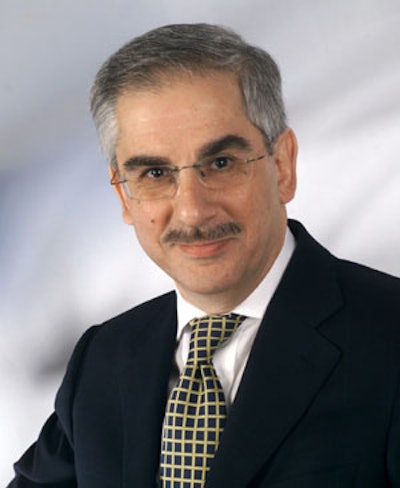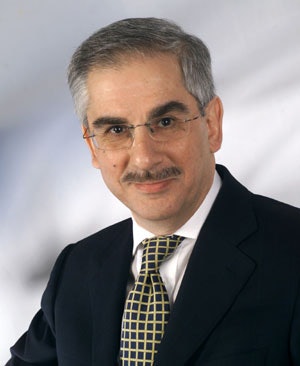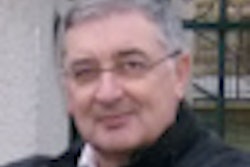
As the curtain rises on the European Congress of Radiology (ECR 2006), AuntMinnie.com is pleased to bring you a conversation with this year's president, professor Andy Adam from the U.K. The professor of interventional radiology at King's College London talks about the meeting ahead, organizational changes in the ECR, interventional radiology, the National Health Service, and more in our exclusive interview.
AuntMinnie: What's in store for this year's ECR?
Professor Adam: One of the most exciting aspects of the ECR is its cutting-edge information technology. This year, in association with the foundation course on musculoskeletal radiology, there will be a self-marking, all-electronic examination, which will enable those attending the course to assess what they have learned. Further development of this project has important implications, as it may prove to be a useful educational tool for radiologists in many countries around the world.
Another innovation is in the structure of the "senior" film viewing panel. Gone is the rather dry approach of unknown cases known to individual experts in specific fields. Instead, there will be two competing teams: North America versus Europe. The participants will dress up appropriately and the marking scheme will be, let's say, idiosyncratic. Fairness will not enter into this matter but fun and excitement certainly will!
 |
| Prof. Andy Adam, M.D. |
Can you recommend some must-see lectures and hot-topic presentations?
There will be two comprehensive new categorical courses at ECR 2006. One will focus on the staging of cancer and the other on thermal ablation of tumors. Both of these are important and topical subjects in diagnostic imaging and in interventional radiology respectively. I am sure they will be very well attended. There will also be four excellent keynote lectures.
As an interventional radiologist, I am particularly looking forward to the Joseph Rösch lecture by Dr. Fred Keller, who will explore the future of interventional radiology, and to the Roentgen lecture by professor David Hawkes, who will talk about advances in imaging guidance for minimally invasive therapy. Professor Krestin will focus on cardiac imaging in his Sir Peter Mansfield lecture and Dr. Sidney Wallace will deliver the inaugural lecture of the congress, and will talk to us about medicine and art. I could not think of a better person to do this, as Dr. Wallace is an accomplished artist as well as a world-famous interventional radiologist.
What about changes in the organizational structure of European radiology?
There are huge changes taking place in the ECR. It is merging with the European Association of Radiology (EAR) to create one society, based on voluntary individual membership, the European Society of Radiology (ESR). This came into existence (in terms of its statutes) on December 10 and will become fully operational in March this year.
There will be a transition period of two years, during which the EAR and ECR will continue to operate alongside the ESR. In 2008 the EAR will be amalgamated into the ESR, and the ECR will become the congress committee of the ESR. This is the most fundamental change that has ever taken place in the structure of radiology in Europe and has enormous implications for education, research, and strategy in imaging in European countries. It is not dissimilar to the American College of Radiology (ACR), the American Roentgen Ray Society (ARRS), and the Radiological Society of North America (RSNA) coming together. During the two-year interim period, there will be two ESR presidents, the first one (2006-2007) drawn from the EAR (Dr. Nick Gourtsoyiannis) and the second one (2007-2008) from the ECR (me). During that time a new constitution will be written and new president elected in 2008.
Over the past several years, IT has become a critical piece of the radiology matrix. What's in store this year for the information technology folks?
In addition to the exciting ECR first that I mentioned above -- the electronic examination -- there have been further improvements and interesting developments in EPOS, the all-electronic scientific exhibition of the ECR. This was first introduced in 2003 and is now being adopted by more and more congresses around the world.
There is a big emphasis on video recording of presentations this year. What are the implications for presenters and conference attendees?
The ECR is committed to electronic education and distance learning. A large number of the lectures delivered during the congress will be accessible on the Web, and we hope that this will increase the value of the ECR, as it will enable people who cannot come to the congress this year to find out about the latest advances in diagnostic and interventional radiology.
As a leader in the field of interventional radiology, what are some of the principal developments you've seen in the past several years?
I think that the biggest single change in interventional radiology in recent years has been in the widespread application of stent technology. Metallic stents have revolutionized the management of many diseases and are rapidly replacing conventional surgery for many conditions. To mention but one example, the use of thoracic aortic stent grafts in patients with aortic trauma has transformed the prognosis of these patients. Another major change is the increasing acceptance of thermal ablation as a method of treatment of many malignant tumors.
What needs to happen in this area is to accumulate substantial data to demonstrate the value of ablation techniques. If this is done, it is likely that complex and difficult surgery, such as partial nephrectomy, will be replaced by thermal ablation carried out on an out-patient basis or with just an overnight stay in hospital.
The data coming in are quite positive in terms of long-term outcomes for a number of interventional therapies. What stands out among the successes and limitations of the current procedures, and the most promising ones? Tell us about esophageal stents.
As I mentioned, metallic stents and ablation are major successes. However, one of the greatest limitations is the application of metallic stents in benign disease. This is largely limited by epithelial hyperplasia, which leads to stent occlusion. When this problem has been solved, as it inevitably will be during the next few years, a whole new area will open up for interventional radiologists. Esophageal stents are one of the many potential applications of these devices. Metallic stents have already changed the management of patients with esophageal cancer, vastly improving the quality of life of patients with irresectable disease. When stents that can be used in benign disease become available, the management of caustic and peptic strictures will be changed completely.
Have minimally invasive therapies been embraced by providers and patients in the U.K. to the same extent as the rest of Europe and the U.S.?
Minimally invasive therapy is extremely well-developed in the U.K. Interventional radiology, in particular, is in a very strong position partly because British radiologists have a clinical background before entering radiological training schemes. This gives them the confidence to practice as clinicians, which is essential for the appropriate use of interventional techniques. Many procedures that are carried out relatively infrequently in the rest of Europe and in the U.S. by interventional radiologists, such as esophageal stent insertion, are frequently undertaken in the U.K. However, there are also some problems: there is a general shortage of radiologists in Britain, and this is even more acute in the case of interventionists. This is holding back the dissemination of certain procedures. There is a concerted drive by the Royal College of Radiologists to deal with this problem, and I hope that we shall see great improvements in the next few years.
After years of massive funds infusions, training initiatives, and reorganization, the National Health Service's current budget woes are in the news again, with reports that overspending may reach 600 million pounds this year. Is there a silver lining in this picture?
This is a very difficult subject, on which I can give you only a very personal view. The National Health Service (NHS) is one of the largest bureaucracies in the world and that reduces its flexibility of response at the local level. The managers that work in the NHS are able and dedicated people who should be trusted to implement local policies depending on the needs of the population in their area. A less centralized structure would probably make better use of the increased funding in the NHS and lead to better outcomes.
In the longer term, do you see the growth of private facilities as helping or hurting the cause of patient care?
As with most things, it depends on how these facilities are used. In my view, development of private facilities by NHS Trusts, allowing them to increase their income and expand their capacity, would be better than the involvement of independent providers. This is partly because, quite understandably, an independent provider has to focus on the most profitable cases, which usually means patients that have relatively uncomplicated conditions that can be dealt with quickly and with relatively low risk.
This could leave NHS hospitals having to cope with more complex and more expensive cases, resulting in a vicious circle of increasing relative costs in the NHS. Also, the quality of the care being provided has to be comparable; one issue that causes me concern is the use of teleradiology. Although this technology is exciting and very useful when used appropriately, it should be understood that it cannot replace the all-important interaction between clinical teams and diagnostic radiologists.
The detection of abnormalities is only one aspect of what we do. Putting them in a clinical context and discussing them with colleagues familiar with the patient's clinical condition is vital.
How has U.K. radiology fared in recent years, both in terms of equipment and trained personnel, and what would you consider being imaging's principal accomplishments and most critical needs moving forward?
During the last few years there has been a large investment in imaging facilities, particularly MRI and CT. However, the increasing applications of multidetector CT, in particular, have led to a concurrent increase in demand. I think there is still a substantial underprovision of imaging facilities in the U.K. compared to the U.S. and most Western European countries. However, the situation is even more difficult in relation to personnel.
The U.K. has fewer trained radiologists than almost any other developed country, and this is causing great problems for the health service in general because modern imaging is pivotal to the delivery of modern medicine. To some extent, radiology is a victim of its own success. The current rapid developments in molecular imaging, functional MRI, CT, and other advances will put increased pressure on what is already a very short-staffed service in diagnostic imaging and interventional radiology in the U.K.
We're pretty sure Wolfgang won't be attending the ECR's "Beatles meet Mozart" party on March 6 at Vienna's but there are some original Beatles kicking around. Any comment?
I am sure that Mozart's spirit will be around that evening at the Semper Depot! As for the Beatles, their enduring popularity confirms my opinion that nobody has produced anything better since the 1960s, which, in turn, allows me to at least try to justify my ignorance of the modern pop music scene to my daughters.



















